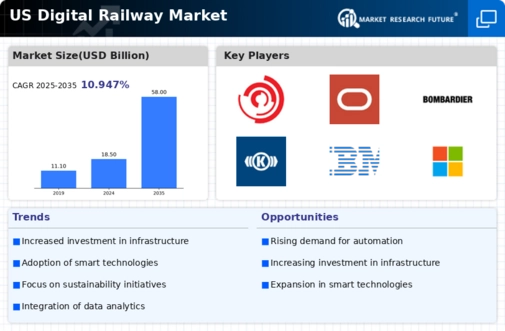The competitive landscape of the US Digital Railway Market is characterized by rapid technological advancements and a growing emphasis on efficiency and safety in rail operations. With increasing investments in infrastructure and the integration of digital technologies, the market is witnessing a transformative phase that is reshaping how rail companies operate. Key players are focusing on developing innovative solutions that enhance operational performance, reduce costs, and improve the overall customer experience. As companies strive to gain a competitive edge, collaborations, strategic partnerships, and advanced tech implementations play a crucial role in ensuring sustained growth and market presence.
This environment encourages continuous improvement and introduces new competitors into the marketplace, as well as expanding opportunities for existing companies.Wabtec has established a strong foothold in the US Digital Railway Market by leveraging its extensive expertise in rail technology and solutions. The company is recognized for its innovative approach to integrating digital advancements with traditional rail operations. Its strengths lie in its comprehensive product offerings that include signaling solutions, train control systems, and data analytics which enhance the safety and efficiency of rail transport.
Wabtec's robust presence in the market is supported by a solid customer base and its commitment to continuous improvement and research and development.
The company's ability to adapt to emerging technologies ensures that it remains a key player in the digital transformation of rail transport, making it a pivotal contributor to enhancing operational standards in the industry.Cisco Systems is another significant player in the US Digital Railway Market, renowned for its strong focus on connectivity and network solutions tailored specifically for rail applications. Cisco offers a variety of key products and services designed to optimize rail communication and operations, including secure networking solutions and cloud-based applications that streamline data exchange across rail networks.
The company's strengths include its advanced cybersecurity measures, extensive experience in networking technologies, and the ability to provide innovative solutions that enhance the efficiency and reliability of rail systems. Cisco has also made strategic partnerships and acquisitions within the industry to enhance its service offerings and market presence. This proactive approach allows Cisco to stay at the forefront of technology trends in the rail sector while addressing the ever-evolving needs of rail operators in the US.






















